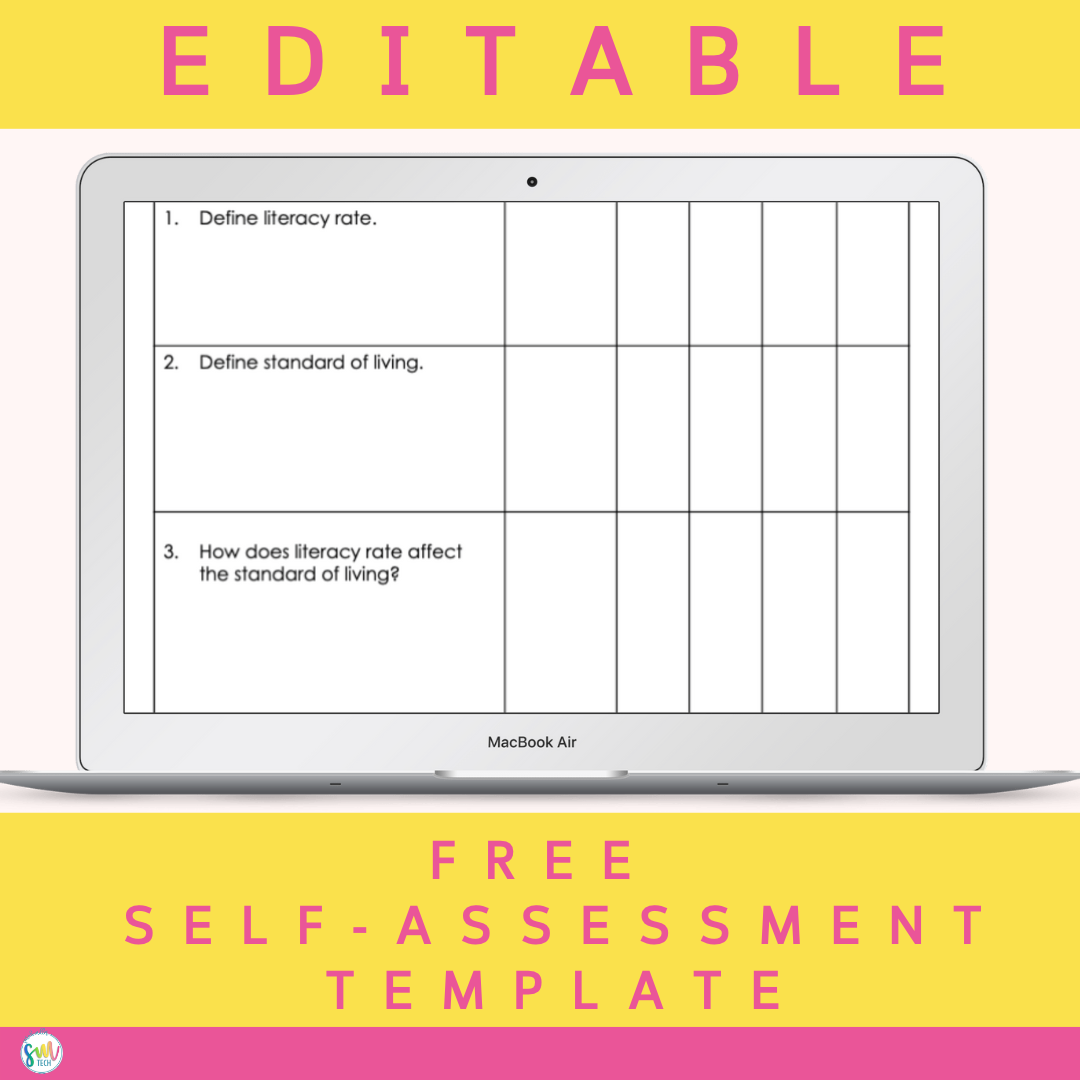How a Student Self-Assessment Helps Improve Student Achievement
“I already know all this stuff”
“I don’t need to study”
“I’m gonna ace this test”
Sound familiar? Let me guess. You heard this just before a student bombed your unit test. I sure did. My 7th grade students were always really confident during study time, but then we struggled with our test grades.
I thought they just didn’t want to study during the time I gave them because they’d rather chat with their neighbor. While that was probably partly true, I began to realize that my students genuinely thought they “knew” the material.
That’s when my “aha” moment happened.
They could skim through their notebook, and know they recognized all the vocabulary and facts. Done. I know it all. Wrong.
They didn’t realize that they weren’t so great at applying the information. They could recall the facts and definitions, but could they apply that to a higher-order prompt? My solution to this: self-assessments.
Editable Template
Self-Assessments made easy.
My Evolution of Self-Assessments
I have to be honest. My first version of self-assessments did not go as planned. I almost gave up on them because it was a waste of time. I created my first version of self-assessments based on ones I found online. They looked similar to the one pictured.
This type of self-assessment is highly ineffective. It does not require students to PROVE their stance. If they say the “know it” on the paper by checking off by the smart-looking emoji, how is that any different from them saying they “know it” before the test? It isn’t. It’s the exact same, except you’ve spent a significant amount of precious instructional time filling out the paper.
This led to my self-assessment evolution. I used self-assessments that required students to PROVE their stance. If they said they knew the content, prove it. If they said they didn’t know the content, learn it.
Learn my tips for designing your self-assessment
Don’t worry, I make it simple. You’ve got this.
Implementing Self Assessments
How
You’ll want to assign this in a way that students find value. Pitch it to them as it’s their way of narrowing down what they need to study. If you can prove that you know most of the content, then you may only need to spend a few minutes studying the rest.
Learn how to create your own effective self-assessment from this blog post.
Allow students to complete the self-assessment WITHOUT using any resources to look up their answers. This could be 20-30 minutes depending on your class. I always hid my timer, so I could move on based on the class. If they need a sense of urgency, “5 minutes left” even if they really have 10 left on your timer. They most likely won’t catch on…
Then, students are allowed to start looking up answers to the ones they didn’t know. Make sure you spot-check that they’ve highlighted these as the lower scale of their knowledge level (emojis, if you’re using them). This is why I recommend putting the page numbers where students can find help with the answers. It will cut down on the length of this process, and your time assisting students. Having students fill in the correct answers encourages them to not skip the first part of the process. It helps avoid the “I don’t know any of it, so I don't have to do this”. Plus, it can act as a study guide!
Last, give students a long sticky note. They usually get excited about getting the sticky note - yes, even middle schoolers! Students will make a list of the pages/topics they need to study on the sticky note. This is their “to-do list”. This is their personalized, narrowed-down list of what they need to study before the test. Of course, I still recommend they review the whole self-assessment (which is now their study guide) before the test. But now, they know what to spend the majority of their time studying. BONUS: Parents love this sticky note strategy with the page numbers. I would send a parent notification that they were coming home, and parents were able to help hold their child accountable.
When
Depending on how much is covered on your test, this process can take a couple of days. I could do a self-assessment for a unit test in 1 or 1.5 class periods. For benchmarks, though, we needed 2 or 3 class periods.
To be most effective, this should not be rushed. You’ll need to plan to give students time to complete the whole process. This should be done in the days leading up to the assessment.
Free 6th Grade Economics Self-Assessment
Editable version. Ready to print and go!
Closing
Self-Assessments can help improve student achievement by allowing the students to discover what they know and don’t know before the real assessment. Additionally, it narrows down a study list that is personalized for each student. If done effectively, leading students through this process will teach them valuable study skills they’ll use for years.
If you want my tips on designing your very own self-assessment, read this blog post! I make it nice and simple!






